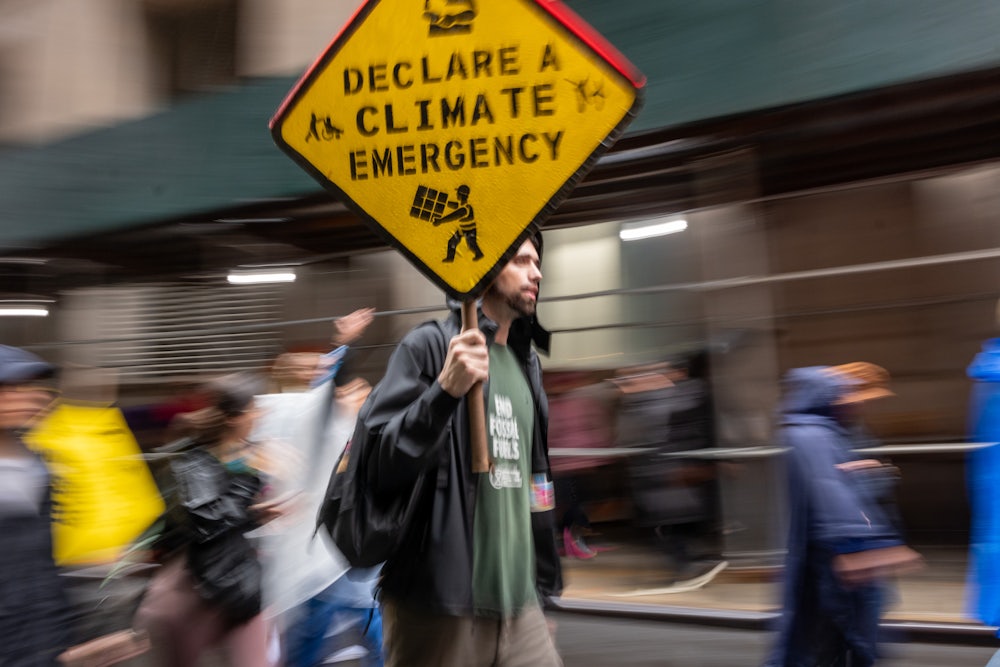Every year around this time in New York City, I become intrigued at the uptick in protests, screenings, art installations, and panel discussions about climate change. I start feeling hopeful: We must finally be getting to the point, as a society, where all our political discourse is about climate, I think to myself. Good! How else are we going to address this crisis?
Inevitably I wake up from this pleasant confusion. I then realize with disappointment that, no, our culture hasn’t simply shifted to talking about climate all the time. This just happens to be Climate Week.
What even is Climate Week, anyway? For the happily uninitiated, Climate Week is an event that began in 2009 and was intended to call public attention to U.N. climate talks at the meeting of that body’s General Assembly in New York. Almost 15 years later, 194 countries have signed on to the Paris Agreement and climate action is progressing—albeit much more slowly than the science requires. Climate Week has grown too—but instead of being an urgent call to action, it is now the closest thing the climate movement has to a trade show, a week of fancy lunches and private drinks and flashy presentations announcing new investment funds, new green pledges from businesses and states, and thought leaders taking the opportunity to show their climate bona fides. After the hottest summer on record, Climate Week now feels decidedly irrelevant and wholly inadequate to the climate challenges we face.
One problem with Climate Week as it stands is the greenwashing. Sponsors this year include the consulting firm McKinsey, which was denounced by more than a thousand of its own employees in 2021 for working with dozens of the world’s most environmentally destructive companies, and utility giant National Grid, which has tried its hardest to use political donations to get destructive pipelines built in New York State. No doubt the original intentions were decent, but Climate Week has devolved into a marketing opportunity for all the worst capitalists (think of International Women’s Day, which was started by radical socialists and anti-war activists and is now fervently celebrated by Lockheed Martin).
Another issue is how Climate Week limits the political sphere. Because of its timing around the U.N. meeting each year, Climate Week implicitly positions the United Nations to the public as the main driver of climate action in the world. While this may have been a sound and strategic framing back in 2009, years before the Paris Agreement was signed, climate action has expanded over the past two decades. The public should know about everyday wins in their own backyard, like New York State’s Build Public Renewables Act, and New York City’s new universal composting. The U.N. process is still invaluable, but climate action is not just the purview of an international body and big meetings—and the tech moguls and wealthy entrepreneurs those meetings bring with them. Policy is made all year long by everyday people, not only once a year in big (carbon-intensive) meetings.
But the biggest problem with Climate Week is the time frame: A week is too short to devote to the most important challenge facing human civilization. It’s insulting to the grieving families of the 11,000 dead and more than 10,000 missing in Libya’s floods last week, the 97 dead in Maui’s wildfires last month, and all those who lost their lives and livelihoods to flooding in Greece late last week, the worst storms in that country in more than a century. Devoting one week a year to public communication on an issue that most people are already worried about is stunningly unserious. If the United States and the USSR had only devoted one week a year to communication about the urgency of fighting Hitler, we’d be living in a much different world today, and not a better one.
Many of the people and organizations involved in Climate Week—with the probable exception of the corporate sponsors—are engaged in pushing for climate action all year long. But that’s not the point: “Climate Week” sends a signal to the public that this issue is an afterthought. Moving to mostly virtual events during the pandemic years helped to make Climate Week even more irrelevant, even as global awareness of the climate crisis grew more acute and climate disasters more severe and frequent, thus more difficult to ignore.
Let’s call it, then: This week’s Climate Week is perhaps best celebrated by acknowledging that Climate Week has run its course. However, while I predict most of the meetings and announcements and presentations in New York over the next few days will be a waste of time, this year’s U.N. Climate Summit has given us one incredibly valuable gift: the return of the visible climate protest movement. That’s one dimension of this year’s Climate Week that should become a daily—or at least monthly—occurrence: street protest.
Last week, as a prelude to Climate Week, hundreds of climate activists staged demonstrations on Wall Street, targeting the financial industry—specifically CitiBank and BlackRock, both of which continue to invest massively in the fossil fuel industry— with confrontational direct action. They blocked the entrances to Citigroup’s headquarters and shut down all traffic in front of BlackRock, the world’s largest asset manager and a top fossil fuel financier.
Tens of thousands of people also turned out on Sunday for a massive march in Manhattan, put on by a broad coalition of groups, from Sunrise, 350, Extinction Rebellion, Fridays for Future, Third Act, the Sierra Club, and the Audubon Society to less-known Indigenous, faith, and environmental justice groups, to labor unions like District Council 37 (public-sector workers) and District Council 9 Painters and Allied Trades, or IUPAT. Protesters chanted, celebrated, danced, and waved butterfly signs but also presented an unusually clear and unified message: no more fossil fuels. Many signs addressed Biden by name—reference to the president’s continued approval of fossil fuel projects, a huge weakness in his climate policy. Others demanded that the president declare a climate emergency.
These actions, in their messaging, represented a robust departure from the amorphous please-do-something energy of past large Climate Week protests. I see them as a signal that the movement has outgrown raising awareness and moved on to the more urgent and political matter of assigning blame, naming the problem, and making clear demands.
Climate Week is a vestige of an earlier era, when climate was one of many issues competing for our attention and doing anything to increase public consciousness felt like important work. That time has passed.
Let’s retire Climate Week—but keep protests like these going all year long.










